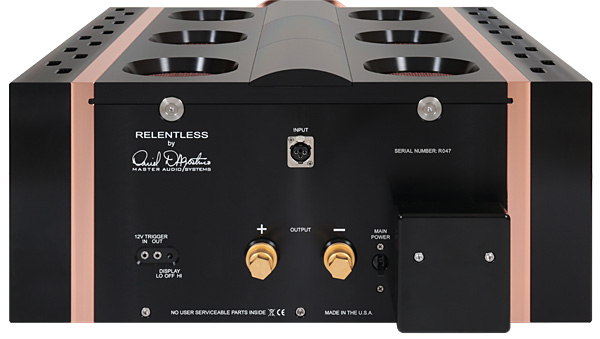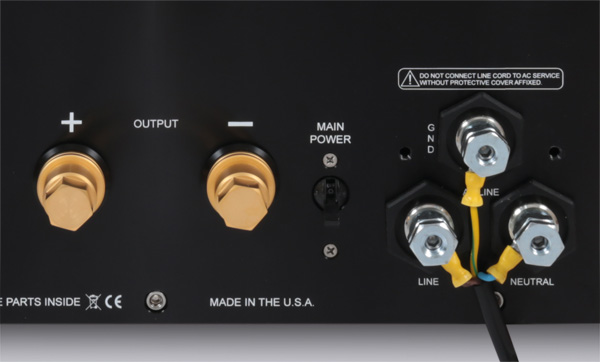D'Agostino Relentless Mono Power Amplifier

 The culmination of one man's 'relentless' quest to develop his 'dream amplifier – an amplifier without any limits' is revealed in this special six-page, in-depth review...
The culmination of one man's 'relentless' quest to develop his 'dream amplifier – an amplifier without any limits' is revealed in this special six-page, in-depth review...
It is not unusual for products featured in Hi-Fi News to rival a family car for cost. But a pair of monoblocks that weigh as much as a car and cost as much as a house? While that is surely breaking new territory for us all, the prospect of 'stretching the envelope' in power output, industrial design and sheer audio performance was clearly uppermost in CEO Dan D'Agostino's mind as he contemplated the next step on from his 400W/8ohm Momentum monoblocks [HFN Oct '16].
Enter the Relentless, a battleship to sink all other flagships, and a statement of intent rivalled only by Wilson's WAMM Master Chronosonic or Magico's Q7 MkII loudspeakers in the elusive quest to inch us that little bit closer to the 'real thing'. We saw the Relentless displayed at Munich's High End 2018, and 2019, but we only heard it for the first time in Europe at our Hi-Fi Show Live in Ascot last October. So this is the first – and possibly the only – full and independent technical test you will read of the hi-fi world's most luxurious, most powerful, heaviest and costliest amplifier... ever. Time to assemble the HFN crew!
Better By The Ton
Pictures alone cannot convey the sheer scale of this amplifier, so here's the Relentless by numbers: each chassis is over a half metre in width (572x280x826mm, whd), weighs over a quarter ton (258kg) and is composed of interlocking slabs of precision-milled copper and aluminium alloy. The latter is a very costly 'aircraft-grade' alloy that guarantees the quality of the 1µm-deep diamond cut finish, gloss black and silver (natural) anodising and hard, synthetic enamel coating. The price, if you need to ask, is an astonishing £125,000 per mono chassis, in either colour. As I say, best not to ask...
Power output is rated at 1.5kW/8ohm, with a theoretically 'perfect' doubling to 3kW/4ohm and 6kW/2ohm. This is at least partially reflected in the 0-1.6kW scale embedded into the eye-catching meter that glares from its fascia. By now a hallmark of the D'Agostino brand, the design resembles watch dials from the 19th century, while the needle is a facsimile of the hour hand created by Abraham Louis Breguet – the greatest watchmaker of all time.

In use you'll regularly see that needle flicking up beyond 300W, but this is 'fake news' – the meters are made to move all the time so that 'users are confident something is going on', admitted Dan, 'fun to look at, but please don't take the numbers too seriously'.
Decorative By Design
Why? Simply put, the early Momentum amplifiers had accurate meters and, with typical real-world outputs being just a few watts for much of the time, the needles were barely moving. I think D'Agostino just got fed up with customers complaining that their amplifiers were faulty! I tested the meter calibration here and can report that with just 1W/8ohm at the output the scale reads 400W, while 20W/8ohm is indicated as a full 1kW. During the real power tests, those needles were slammed into their end stops and all but bending under the strain.
Under the bonnet, D'Agostino has specified a suitably robust power supply, with a fully-screened 5kVA toroidal mains transformer that weighs some 35kg in its own right. The 'standby' and control circuitry transformer, adjacent, looks small but is still bigger than those fitted to some modest integrated amplifiers!
This custom PSU is supported by a bank of six huge 100,000µF electrolytics that are clamped firmly into place by a Delrin 'Coke can holder' designed to mitigate any potential microphony [see Investigation, HFN Jul '18]. The transformer has a split secondary winding that feeds two sets of rectifiers – these are not destined for each half of the amplifier but are combined to feed both sides of the amplifier in tandem. This is a mono chassis, but the amplifier is a story of two perfectly balanced sides.

In order to achieve a very high power, typically beyond about 500W/8ohm, most high-end amplifiers employ a bridged output, doubling the available voltage by combining two amplifiers, one out of phase with the other. The Relentless is a true balanced design that uses a single differential input amplifier, a current mirror circuit, to derive the mirrored (plus and minus) audio rails.
Transistor Farm
Even-order distortions are suppressed, if not entirely cancelled by this technique, which is just one reason why D'Agostino has reduced the overall feedback, or compensation, employed in the design. Also key is the 'super rail' PSU that offers a headroom of some 20% for this input stage. The following current gain stage runs on the same rails as the output stage, the latter employing purely complementary drivers and output devices, all from ON Semiconductor.
This output stage is a huge 'transistor farm' staged over eight separate parallel amplifier modules – it is simply impractical to fabricate a single PCB to host this many devices. Each module has eight complementary pairs of bipolar power transistors, adding up to 128 devices per mono chassis.
Moreover, every power transistor is hand-matched to create the ideal complementary pair and each pair grouped to ensure optimum symmetry. So, with as many drivers as output devices, the Relentless functions as 32 smaller, fast power amps in parallel per balanced side.
There's no Zobel or other stabilising network on the output as the Relentless is specified as unconditionally stable into any likely load.

Turning Up The Heat
Unsurprisingly, this many richly-biased devices generates a good deal of heat that requires dissipation. The amplifier modules are bolted to two 23kg copper slabs that are clamped to its custom external heatsinking – a variation on the passive Venturi cooling system first seen on the Momentum, machined here into two 22kg alloy blocks. So the Relentless is also an effective, albeit costly, storage heater, raising the temperature in my listening room by 5oC over a 48hr period.
Do Not Touch
Much of what I have described is readily identifiable from our 'lid off' shot. While I absolutely do not recommend lifting the lid, neither is this an inelegant pressed metal top plate. It's another milled-from-solid interlocking section, complete with six decorative vents, and secured in place by just two large Allen bolts at the rear. Release these and the top surface slides out.
While dancing around the subject of safety, I should also make mention of D'Agostino's AC inlet solution. Not for the Relentless a standard 13/15A IEC mains socket, instead the rear of the amp includes three 500A lugs to which the live, neutral and earth connections are cranked very tightly into place. A torque wrench is provided for the purpose, Dan's view being 'enthusiasts can use whatever AC mains cable they like here, or even wire straight to a fusebox'. There's a note in the packing crate recommending that purchasers have a qualified electrician on hand to wire-up the 120V/240V connections. A thick Delrin box is supplied that bolts into position, covering all contacts at AC mains potential.
Ever resourceful, this torque wrench also services D'Agostino's huge gold-plated speaker outlets, allowing you to crush your favoured bare-wire/spade cable terminations into position. The line input is achieved by less violent means – a simple balanced XLR connection suffices here.
Countdown To Liftoff
Once you have the Relentless(s) positioned – adjacent to your loudspeakers seems de rigueur – and securely clamped to the AC mains, a breaker switch is accessed on the rear panel. This puts the amp into standby and that 200mm watchface meter is illuminated in red. The main power button is hidden just underneath the front face, near the stainless steel foot on the right hand side. Turn-on is absolutely silent, and aside from the faint ticking of relays as the PSU 'boots up', there are no pops or other extraneous noises. Output protection too, is 100% 'analogue' for DC, over-temperature and over-current. If you run it into a short it will shut off. Or your speaker wires may melt, whichever occurs first.
![]() The Ultimate Journey
The Ultimate Journey
Let's cut to the chase: this past month the rumour mill was working overtime and just about every audiophile I know was asking 'so just how good are these amplifiers?'. Certainly, I had the luxury of living with these behemoths for longer than is decent, but to merely describe their sound in the hi-fi vernacular is perilously close to missing the point. It would be like defining a McLaren Speedtail by its top speed or the top notes of that 2003 Sassicaia I have tucked away in the cellar by the DNA of its Cabernet Sauvignon grapes.


















































